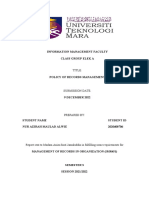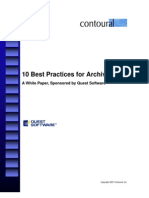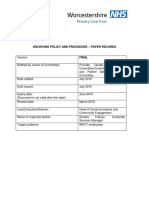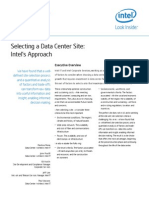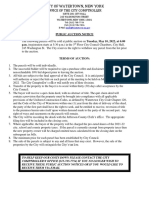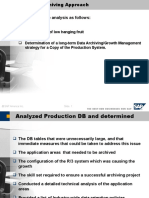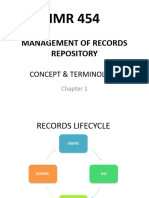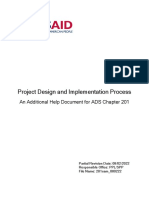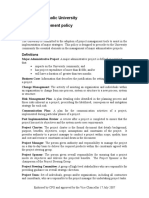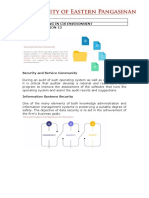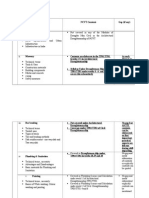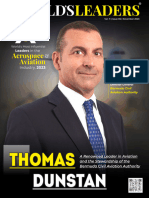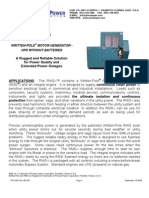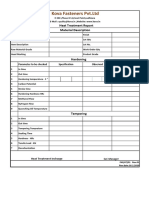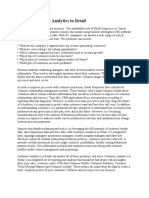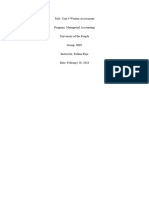Standardization in e-archiving
Alain WAHL
ILNAS
28th November 2014
Summary
Introduction
ISO/TC 46 Information and documentation
ISO/TC 46/SC 11 Archives/records management
ISO 3030x series Management systems for records
ISO 30300:2011 Fundamentals and vocabulary
ISO 30301:2011 Requirements
Draft International Standards
Revision of ISO 15489-1 Records management Concepts and
principles
ISO/DIS 30302 MSRs Guidelines for implementation
ISO 14641-1: 2012 Specifications for electronic information preservation
Conclusion
2
Summary
Introduction
ISO/TC 46 Information and documentation
ISO/TC 46/SC 11 Archives/records management
ISO 3030x series Management systems for records
ISO 30300:2011 Fundamentals and vocabulary
ISO 30301:2011 Requirements
Draft International Standards
Revision of ISO 15489-1 Records management Concepts and
principles
ISO/DIS 30302 MSRs Guidelines for implementation
ISO 14641-1: 2012 Specifications for electronic information preservation
Conclusion
3
Introduction
Electronic documents are an essential part of everyday business, whether the
sources are incoming communications or output of organizations (Paperless
office)
As one type of information source, records are part of the intellectual
capital, and therefore assets, of an organization
Records are evidence of business activity, and information assets
Management system for records:
Defined roles and responsibilities;
Systematic processes;
Measurement and evaluation;
Review and improvement.
4
Summary
Introduction
ISO/TC 46 Information and documentation
ISO/TC 46/SC 11 Archives/records management
ISO 3030x series Management systems for records
ISO 30300:2011 Fundamentals and vocabulary
ISO 30301:2011 Requirements
Draft International Standards
Revision of ISO 15489-1 Records management Concepts and
principles
ISO/DIS 30302 MSRs Guidelines for implementation
ISO 14641-1: 2012 Specifications for electronic information preservation
Conclusion
5
ISO/TC 46 Information and documentation
Secretariat: AFNOR
Creation date: 1947
Total number of published standards (number includes updates): 111
Number of published standards under the direct responsibility of ISO/TC46 : 32
Participating countries:
38
Observing countries:
35 (including Luxembourg)
ISO/TC 46 Information and documentation Scope
Standardization of practices relating to
Libraries
Documentation and information centers
Publishing
Archives
Records management
Museum documentation
Indexing and abstracting services
Information science
7
ISO/TC 46 Information and documentation Objectives
Ensure consistency of the standards that address various areas of information
and documentation, together with other ISO standards
Encourage the contribution of all kinds of organizations dealing with information
and documentation.
Improve global representation of standardization experts
Finalize and publish standards required by the market in order to focus efforts
in this area
Encourage private and public sector to use ISO standards
ISO/TC 46 Information and documentation Evolution
Production of electronic documents and multimedia
Possibilities of digital information
The traditional references for managing documents are no longer up to date
Pushing the market to react.
The exchange of information in electronic form
Has become widespread
No longer just a specialized area for booksellers and archivists.
Conception of standards for the record management and electronic archiving
Becomes a requirement
Emerged by the appearance of new information and communication
technologies.
TC 46/SC 11
To provide guidance in the field of record management
9
ISO/TC 46 Information and documentation Subcommittees
ISO/TC 46/SC 4 Secretariat
Technical interoperability
Standardization of protocols, schemes, etc., and related models and
metadata for processes used by information organizations and content
providers, including libraries, archives, museums, publishers, and other
content producers
ISO/TC 46/SC 8
Quality - Statistics and performance evaluation
Standardization of practices relating to the collection of statistics and
performance indicators for information organizations and content
providers, e.g., libraries, archives, museum, and publishers
10
ISO/TC 46 Information and documentation Subcommittees
ISO/TC 46/SC 9
Identification and description
Standardization of information identifiers, description and associated
metadata and models for use in information organizations and the content
industries
ISO/TC 46/SC 10
Requirements for document storage and conditions for preservation
Standardization of requirements for storage and use of documents in
libraries, archives and documentation centers, as well as practices related
to maintenance and improvement of the conditions of preservation
11
Summary
Introduction
ISO/TC 46 Information and documentation
ISO/TC 46/SC 11 Archives/records management
ISO 3030x series Management systems for records
ISO 30300:2011 Fundamentals and vocabulary
ISO 30301:2011 Requirements
Draft International Standards
Revision of ISO 15489-1 Records management Concepts and
principles
ISO/DIS 30302 MSRs Guidelines for implementation
ISO 14641-1: 2012 Specifications for electronic information preservation
Conclusion
12
ISO/TC 46 Information and documentation Subcommittees
ISO/TC 46/SC 11
Archives/records management
Standardization of principles for the creation and management of
documents, records and archives as evidence of transactions and
covering all media including digital multimedia and paper
Secretariat: Standards Australia
Creation date: 1998
Number of published ISO standards under the direct responsibility of
ISO/TC 46/SC 11 (number includes updates): 17
Participating countries:
28 (including Luxembourg)
Observing countries:
15
13
ISO/TC 46/SC 11 Archives/records management
ISO/TC 46/SC 11/WG 1
Metadata
ISO/TC 46/SC 11/SWG
Program coordination group
ISO/TC 46/SC 11/WG 7
JWG on Digital records preservation
ISO/TC 46/SC 11/WG 8
Management systems for records
ISO/TC 46/SC 11/WG 10 Implementation Guidelines for the disposition of
records
ISO/TC 46/SC 11/WG 13 Revision of ISO 15489-1 and ISO/TR 15489-2
14
ISO/TC 46/SC 11 Archives/records management
ISO committees in liaison:
ISO/IEC JTC 1/SC 27 - IT Security techniques
ISO/IEC JTC 1/SC 32 - Data management and interchange
ISO/IEC JTC 1/SC 38 - Distributed application platforms and services
ISO/TC 20/SC 13 - Space data and information transfer systems
ISO/TC 154 - Processes, data elements and documents in commerce,
industry and administration
ISO/TC 171/SC 1 - Quality
ISO/TC 171/SC 2 - Application issues
ISO/TC 176 - Quality management and quality assurance
ISO/TC 176/SC 1 - Concepts and terminology
ISO/TC 176/SC 2 - Quality systems
ISO/TC 176/SC 3 - Supporting technologies
ISO/TC 207 - Environmental management
ISO/TC 207/SC 1 - Environmental management systems
ISO/TC 262 - Risk management
ISO/CASCO - Committee on conformity assessment
15
Summary
Introduction
ISO/TC 46 Information and documentation
ISO/TC 46/SC 11 Archives/records management
ISO 3030x series Management systems for records
ISO 30300:2011 Fundamentals and vocabulary
ISO 30301:2011 Requirements
Draft International Standards
Revision of ISO 15489-1 Records management Concepts and
principles
ISO/DIS 30302 MSRs Guidelines for implementation
ISO 14641-1: 2012 Specifications for electronic information preservation
Conclusion
16
ISO 3030x series Management systems for records
ISO 30300:2011 Management systems for records Fundamentals and
vocabulary
ISO 30301:2011 Management systems for records Requirements
ISO/DIS 30302 Management systems for records Guidelines for
implementation
Technically based on ISO 15489 Records Management
Mainly deals with operational and technical aspects of record
management
Not replaced by the ISO 3030x series, but complemented
Principles are in the implementation of ISO 30300/30301 necessarily to be
taken into account and applied
Focus of standardization is put on the organization (management system)
Show how records management is controlled and monitored
17
ISO 30300:2011 Fundamentals of management system for records
18
Summary
Introduction
ISO/TC 46 Information and documentation
ISO/TC 46/SC 11 Archives/records management
ISO 3030x series Management systems for records
ISO 30300:2011 Fundamentals and vocabulary
ISO 30301:2011 Requirements
Draft International Standards
Revision of ISO 15489-1 Records management Concepts and
principles
ISO/DIS 30302 MSRs Guidelines for implementation
ISO 14641-1: 2012 Specifications for electronic information preservation
Conclusion
19
ISO 30300:2011 Fundamentals of management system for records
1. Scope
Establish, implement, maintain and improve a MSR to support its business
Assure itself of conformity with its stated records policy
Demonstrate conformity with this International Standard
Undertaking a self-assessment and self-declaration, or
Seeking confirmation by a party external to the organization, or
Seeking certification of its MSR by an external party.
20
ISO 30300:2011 Fundamentals of management system for records
2.1 Relation between the MSR and the management system
Establish policy, objectives and directives framework
Establish processes and controls
Establish implementation and monitoring
Manage records of management system
21
ISO 30300:2011 Fundamentals of management system for records
2.2 Context of the organization
An organization can use all or any element of the standards on MSR according
to its business context and requirements, which include:
Size and complexity of the organization
Level of business risk of having inadequate records controls
Drive for internal improvement to satisfy stakeholder demand
Specific stakeholder demands or expectations
22
ISO 30300:2011 Fundamentals of management system for records
2.3 Need for a MSR 2.3.1 Purpose
Conduct business and deliver services efficiently;
Meet legislative, regulatory and accountability requirements;
Optimize the decision-making, operational consistency and continuity;
Facilitate the effective operation of an organization in the event of a disaster;
Provide protection and support in litigation, including the management of risks
associated with the existence of, or lack of evidence of organizational activity;
Support research and development activities;
Support the promotional activities of the organization;
Maintain corporate or collective memory and support social responsibility
23
ISO 30300:2011 Fundamentals of management system for records
2.3 Need for a MSR 2.3.2 Reliable, authentic and useable records
Creation and control of records which are
Reliable;
Authentic;
Have integrity;
Are useable.
2.3 Need for a MSR 2.3.3 Establishment of records system
Record system to capture and control records which are reliable, secure,
compliant, comprehensive and systematic
24
ISO 30300:2011 Fundamentals of management system for records
2.4 Principle of a MSR
2.4.1 General
2.4.2 Customer and other stakeholder focus
2.4.3 Leadership and accountability
2.4.4 Evidence-based decision making
2.4.5 Involvement of people
2.4.6 Process approach
2.4.7 System approach to management
2.4.8 Continual improvement
25
ISO 30300:2011 Fundamentals of management system for records
2.5 Process approach to a MSR
26
ISO 30300:2011 Fundamentals of management system for records
2.6 Role of top management
Policy direction comes from top management in order to :
Achieve consistency of operation throughout the organization;
Mandate employee adoption of the requirements of a MSR;
Ensure that business processes are transparent and comprehensible;
Assure that records are being properly managed
27
ISO 30300:2011 Fundamentals of management system for records
2.7 Relationships with other management systems
Integration of MSR into an organizations overall management systems aims to:
Optimize processes by integrating records processes with other activities;
Support evidence-based decision making;
Promote consistency between management systems;
Meet and improve evidence of meeting compliance requirements.
28
ISO 30300:2011 Fundamentals of management system for records
3 Terms and definitions
3.1 Terms relating to records
3.1.4 Documentation
Collection of documents describing operations, instructions, decisions,
procedures and business rules related to a given function, process or
transaction.
3.1.5 Evidence
Documentation of a transaction.
3.1.7 Record(s)
Information created, received and maintained as evidence and as an asset by
an organization or person, in pursuit of legal obligations or in the transaction of
business.
29
ISO 30300:2011 Fundamentals of management system for records
3.2 Terms relating to management
3.2.2 Nonconformity
Non-fulfilment of a requirement
3.2.3 Organization
Person or group of people that has its own functions with responsibilities,
authorities and relationships to achieve its objectives
3.2.4 Records policy
Overall intentions and direction of an organization in relation to management
systems for records, formally expressed by top management
3.2.5 Top management
Person or group of people who directs and controls an organization at the
highest level
30
ISO 30300:2011 Fundamentals of management system for records
3.3 Terms relating to records management processes
3.3.1 Access
Right, opportunity, means of finding, using, or retrieving information.
3.3.2 Classification
Systematic identification and arrangement of business activities and/or records
into categories according to logically structured conventions, methods, and
procedural rules represented in a classification system.
3.3.3 Conversion
Process of changing records from one format to another.
3.3.4 Destruction
Process of eliminating or deleting a record, beyond any reconstruction.
3.3.9 Preservation
Processes and operations involved in ensuring the maintenance of records
over time.
31
ISO 30300:2011 Fundamentals of management system for records
3.4 Terms relating to MSR
3.4.1 Management system
Set of interrelated or interacting elements of an organization to establish
policies and objectives, and processes to achieve those objectives.
3.4.2 Management system for records
Management system to direct and control an organization with regard to
records.
3.4.3 Records management
Field of management responsible for the efficient and systematic control of the
creation, receipt, maintenance, use and disposition of records, including
processes for capturing and maintaining evidence of and information about
business activities and transactions in the form of records.
3.4.4 Records system
Information system which captures, manages and provides access to records
over time.
32
Summary
Introduction
ISO/TC 46 Information and documentation
ISO/TC 46/SC 11 Archives/records management
ISO 3030x series Management systems for records
ISO 30300:2011 Fundamentals and vocabulary
ISO 30301:2011 Requirements
Draft International Standards
Revision of ISO 15489-1 Records management Concepts and
principles
ISO/DIS 30302 MSRs Guidelines for implementation
ISO 14641-1: 2012 Specifications for electronic information preservation
Conclusion
33
ISO 30301:2011 Management systems for records Requirements
1 Scope
2 Normative references
ISO 30300, Management systems for records Fundamentals and vocabulary
3 Terms and definitions
Terms and definitions given in ISO 30300 apply
34
ISO 30301:2011 Management systems for records Requirements
4 Context of the organization
4.1 Understanding of the organization and its context
a) Social, legal and financial aspects of the organization
b) Key indicators of the organization
c) Relations with stakeholders
4.2 Business, legal and other requirements
a) Legal requirements
b) Contractual requirements
c) Treaties
35
ISO 30301:2011 Management systems for records Requirements
4.3 Defining the scope of the MSR
a) Definition and documentation of the scope
Whole of the organization or
Specific functions of the organization
b) Scope for externalized activities
36
ISO 30301:2011 Management systems for records Requirements
5 Leadership
5.1 Management commitment
a) Ensuring the MSR is compatible with the strategic direction of the organization,
b) Integrating the MSR requirements into the organization's business processes,
c) Providing the resources to establish, implement, maintain and continually
improve the MSR,
d) Communicating the importance of an effective MSR and conforming to the
MSR requirements,
e) Ensuring that the MSR achieves its intended outcomes, and
f)
Directing and supporting continual improvement.
37
ISO 30301:2011 Management systems for records Requirements
5.2 Policy
a) Be appropriate to the purpose of the organization,
b) Provide the framework for setting records objectives,
c) Include a commitment to satisfy applicable requirements,
d) Include a commitment to continual improvement of the MSR,
e) Be communicated within the organization, and
f)
Be available to interested parties, as appropriate.
38
ISO 30301:2011 Management systems for records Requirements
5.3 Organizational roles, responsibilities and authorities
Management responsibilities
a) Responsible for ensuring that the MSR is established, implemented and
maintained in accordance with the requirements of ISO 30301:2011,
b) Promotion of awareness of the MSR throughout the organization, and
c) Roles and responsibilities defined in the MSR are properly assigned and
that the personnel performing these roles are competent to perform them.
Operational responsibilities
a) Implementing the MSR at the operational level,
b) Reporting to the top management on the effectiveness of the MSR for
review, including recommendations for improvement.
39
ISO 30301:2011 Management systems for records Requirements
6 Planning
6.1 Actions to address risks and opportunities
Determine the risks and opportunities that need to be addressed in order to
a) Assure the MSR can achieve its intended outcome(s),
b) Prevent undesired effects, and
c) Realize opportunities for improvement.
6.2 Records objectives and plans to achieve them
Top management shall ensure
a) That records objectives are established and
b) Communicated for relevant functions and levels within the organization.
40
ISO 30301:2011 Management systems for records Requirements
7 Support
7.1 Resources
a) Assigning responsibility to personnel competent to perform the roles assigned
in the MSR,
b) Periodic review of the competencies and training of those personnel, and
c) Maintenance and sustainability of resources and technical infrastructure.
41
ISO 30301:2011 Management systems for records Requirements
7.2 Competence
a) Determine the necessary competence of person(s) doing work under its
control that affects the performance of its records processes and systems,
b) Ensure these persons are competent on the basis of appropriate education,
training, and experience,
c) Where applicable, take actions to acquire the necessary competence and
evaluate the effectiveness of the actions taken, and
d) Retain appropriate documented information as evidence of competence.
42
ISO 30301:2011 Management systems for records Requirements
7.3 Awareness and training
The organization shall ensure that its personnel are aware of
a) The relevance and importance of their individual activities and how they
contribute to the achievement of the MSR objectives,
b) The importance of conformity with the MSR policy and procedures and with
the requirements of the management system,
c) The significant MSR issues and related actual or potential impacts associated
with their work and the benefits of improved personal performance,
d) Their roles and responsibilities in achieving conformity with the requirements of
the MSR, and
e) The potential consequences of departure from specified procedures.
43
ISO 30301:2011 Management systems for records Requirements
7.4 Communication
The organization shall establish, implement, document and maintain procedures
for internal communication about the MSR and its records policy and objectives.
7.5 Documentation
a) The organization shall document its MSR, including authorized statements of:
b) The scope of the MSR;
c) The policy and objectives;
d) The relationships between the MSR and the other management systems;
e) Documented procedures as required by this International Standard;
f)
Documentation determined by the organization to be necessary to ensure the
effective planning, operation and control of its processes.
44
ISO 30301:2011 Management systems for records Requirements
8 Operation
8.1 Operational planning and control
The organization shall determine, plan, implement and control those processes
needed to address the risks and opportunities
8.2 Design of records processes
To establish the MSR, the organization shall design the records processes:
a) Analyse work processes in order to determine the requirements for records
creation and control in relation to continuing operations
b) Assess the risks that might be incurred through failure to control authentic,
reliable and useable records of the organization's business processes
c) Specify the processes for creating and controlling records and how they are to
be performed in systems, and choose the technological tools to be used.
45
ISO 30301:2011 Management systems for records Requirements
8.3 Implementing of records systems
a) Implement the records processes in records systems to meet the records
objectives;
b) Establish regular monitoring of the performance of the records systems
against business requirements and records objectives.
46
ISO 30301:2011 Management systems for records Requirements
9 Performance evaluation
9.1 Monitoring, measurement, analysis and evaluation
Evolution of the management system
Performance of the management system
Customer satisfaction
9.2 Internal system audit
Conformity assessment of the MSR
47
ISO 30301:2011 Management systems for records Requirements
9.3 Management review
The management review shall consider:
a) The status of actions from previous management reviews;
b) Changes in external and internal issues that are relevant to the MSR;
c) Information on the performance of records processes and systems, including
trends in
1) Nonconformities and corrective actions,
2) Monitoring and measurement evaluation results, and
3) Audit results;
d) Opportunities for continual improvement.
48
ISO 30301:2011 Management systems for records Requirements
10 Improvement
10.1 Nonconformity control and corrective actions
Identify nonconformities,
React to the nonconformities.
10.2 Continual improvement
The organization shall continually improve the effectiveness of the MSR through
The use of the records policy and records objectives,
Audit results and analysis of data,
Corrective and preventive actions and
Management evaluation.
49
Summary
Introduction
ISO/TC 46 Information and documentation
ISO/TC 46/SC 11 Archives/records management
ISO 3030x series Management systems for records
ISO 30300:2011 Fundamentals and vocabulary
ISO 30301:2011 Requirements
Draft International Standards
Revision of ISO 15489-1 Records management Concepts and
principles
ISO/DIS 30302 MSRs Guidelines for implementation
ISO 14641-1: 2012 Specifications for electronic information preservation
Conclusion
50
Four major stages
PROPOSITION
Average
duration :
3 years
Following an identified need, one
party introduces a project
STUDY & PREPARATION
A technical committee prepares
the study and presents the
standards project
PUBLIC INQUIRY &
APPROBATION
The standards project
undergoes public inquiry then it
is presented for validation
PUBLICATION
The valid standard is then
published
51
Example: The ISO procedure for standardization design (Procedure CEN = identical)
The various stages
Stade
prliminaire
(00)
Stade
publication
(60)
Stade
proposition
(10)
Stade
prparatoire
(20)
Stade
approbation
(50)
Stade
enqute
(40)
Stade
comit
(30)
52
Stage
00
Preliminary
stage
In detail
Name of project
Preliminary Work Item
(PWI)
Operation
Inscription of a Preliminary Work Item on
the agenda of a TC/SC
Majority of (P) members
- Majority of simple (P)
members
- > 5 (P) members participants
10 Proposal
stage
New Proposal (NP)
Submission of voting proposal to the
members of the TC/SC concerned
20 - Draft
stage
Working Draft (WD)
Establishment of a working group
30
Committee
stage
Committee Draft (CD)
Diffusion of the project for comments and
votes among the (P) members of the
TC/SC
40 Inquiry
stage
Draft International
Standard (DIS)
Distribution of the standards project (DIS)
to all committees in ISO for votes and
comments
50
Approbation
stage
Final Draft
International Standard
(FDIS)
60 Publication
stage
International Standard
(IS)
Approbation
Distribution of the final draft (FDIS) to all
committee members of ISO for final vote by
YES or NO
The international standard is published
Average
duration
Defined by
a working
group
Agreement on consensus
- 2/3 of (P) members du TC/SC
- Negative Votes < 1/4 of total
votes
5 months
2 months
53
Periodical review of the standards
Publication of the standard
(Stage 60)
3 years
Review of the standard by all committees of the ISO
(Stage 90)
Confirmation
Revision
Annulations
Then, all standards are reviewed every 5 years by all committees of the
ISO
54
55
Summary
Introduction
ISO/TC 46 Information and documentation
ISO/TC 46/SC 11 Archives/records management
ISO 3030x series Management systems for records
ISO 30300:2011 Fundamentals and vocabulary
ISO 30301:2011 Requirements
Draft International Standards
Revision of ISO 15489-1 Records management Concepts and
principles
ISO/DIS 30302 MSRs Guidelines for implementation
ISO 14641-1: 2012 Specifications for electronic information preservation
Conclusion
56
Revision of ISO 15489-1 Records management Part 1: Concepts
and principles
Elaborated in WG13
Foundation standard on the management of records
Establishes the core concepts and principles for
The creation,
Capture and
Management of records
57
Revision of ISO 15489-1 Records management Part 1:
Concepts and principles Benefits
According to ISO 15489-1 Draft DIS version 0.7:
Business to be conducted in an efficient and consistent manner;
Effective policy formation and informed decision making;
The management of business risks;
The establishment of rights and obligations of organizations and individuals;
Continuity in the event of disaster;
Compliance with legislation and regulations;
Protection and support in litigation;
Transparency and accountability;
The conduct of evidence based research and development activities.
58
Revision of ISO 15489-1 Records management Part 1: Concepts
and principles
This International Standard is based on the following principles:
a) The creation and use of records is an integral part of doing business, in any
context;
b) Records consist of content and persistently linked metadata;
c) In order to act as authoritative evidence of business, records - regardless of
form or structure - should possess the characteristics of authenticity, reliability,
integrity and usability;
d) Decisions regarding the creation, capture and management of records are
based on risk assessment of business activities and work processes, in their
business, legal and societal context; and
e) Processes for creating, capturing and managing records rely on the
implementation of policies and responsibilities, the availability of up-to-date
records controls and appropriately implemented records systems.
59
Revision of ISO 15489-1 Records management Part 1: Concepts
and principles
60
Summary
Introduction
ISO/TC 46 Information and documentation
ISO/TC 46/SC 11 Archives/records management
ISO 3030x series Management systems for records
ISO 30300:2011 Fundamentals and vocabulary
ISO 30301:2011 Requirements
Draft International Standards
Revision of ISO 15489-1 Records management Concepts and
principles
ISO/DIS 30302 MSRs Guidelines for implementation
ISO 14641-1: 2012 Specifications for electronic information preservation
Conclusion
61
ISO/DIS 30302 MSRs Guidelines for implementation
Structure of ISO 30301:2011
Provide practical guidance
On how to implement a MSR within an organization
Describing the activities to be undertaken to meet the requirements of ISO
30301
How to document those activities
For every clause :
Objective of the clause
Expected outcome
62
ISO/DIS 30302 MSRs Guidelines for implementation
For each clause of ISO 30301 this International Standard provides:
a) One or more activities necessary to meet the requirements of ISO 30301
activities can be done sequentially, and some will need to be done
simultaneously using the same contextual analysis,
b) Inputs to the activities these are the starting points, and can be outputs from
previous activities,
c) Outputs describing the results or deliverables on completion of the activities.
63
ISO/DIS 30302 MSRs Guidelines for implementation Clause 4
How to perform the analysis needed to implement a MSR
From this analysis the scope of the MSR is defined, and
The relationship between implementing a MSR and other management
systems is identified.
64
ISO/DIS 30302 MSRs Guidelines for implementation Clause 5
How to gain the commitment of top management.
The commitment is expressed in
A records policy
The assignment of responsibilities
Planning the implementation of the MSR and
Adopting records objectives.
65
ISO/DIS 30302 MSRs Guidelines for implementation Clause 6 & 7
The planning (6) is informed by
High-level risk assessment, the contextual analysis (4), and
The resources available (7).
Clause 7 outlines the support needed for the MSR, such as
Resources,
Competence,
Training and communication, and
Documentation.
66
ISO/DIS 30302 MSRs Guidelines for implementation Clause 8
Defining or reviewing and planning the records processes to be implemented.
It draws on the records requirements and scope (4), and
Is based on the records policy (5.2),
The risk assessment (6) and
Resources (7) to meet the records objectives (6.2) in the planned
implementation.
Explains what records processes and systems need to be implemented for a
MSR.
For undertaking the detailed design, review and implementation of records
processes and systems, records professional(s) draw on the standards and
technical reports on records management issued by ISO/TC 46/SC 11.
67
ISO/DIS 30302 MSRs Guidelines for implementation Clause 9 & 10
Performance evaluation and
Improvement against the
Planning,
Objectives and
Requirements of ISO 30301.
68
Summary
Introduction
ISO/TC 46 Information and documentation
ISO/TC 46/SC 11 Archives/records management
ISO 3030x series Management systems for records
ISO 30300:2011 Fundamentals and vocabulary
ISO 30301:2011 Requirements
Draft International Standards
Revision of ISO 15489-1 Records management Concepts and
principles
ISO/DIS 30302 MSRs Guidelines for implementation
ISO 14641-1: 2012 Specifications for electronic information preservation
Conclusion
69
ISO 14641-1: 2012 Specifications concerning the design and the
operation of an information system for electronic information preservation
Elaborated by ISO/TC 171: liaison committee of TC46: Document management
applications, SC3, General issues
The objectives of secure information systems are to resolve organizational
issues such as
Optimization of long-term electronic document preservation, archiving and
integrity
Provision of information search facilities
Ensuring ease of access and use of electronic documents
70
ISO 14641-1: 2012 Scope
Set of technical specifications and organizational policies to be implemented for
the capture, storage and access of electronic documents.
Ensures legibility, integrity and traceability of the documents for the duration of
their preservation.
Applicable to electronic documents resulting from:
The scanning of original paper of microform documents
The conversion of analogue audio or video content
The native creation by information system application
Other sources that create digital content
Intended for the following users:
Organizations implementing information systems
Organizations providing information technology services
Organization providing third-party document archiving services
71
Summary
Introduction
ISO/TC 46 Information and documentation
ISO/TC 46/SC 11 Archives/records management
ISO 3030x series Management systems for records
ISO 30300:2011 Fundamentals and vocabulary
ISO 30301:2011 Requirements
Draft International Standards
Revision of ISO 15489-1 Records management Concepts and
principles
ISO/DIS 30302 MSRs Guidelines for implementation
ISO 14641-1: 2012 Specifications for electronic information preservation
Conclusion
72
Conclusion
The management of records is about ensuring
That records are created and captured to meet requirements for evidence
of business activity and
That they are maintained and managed appropriately over time.
ISO 15489 should be used in conjunction with the ISO 3030x series
To operate and improve a Management System for Records
These standards are complementary
ISO 15489 describes the core activities in managing records
ISO 3030x series links the management of records to organizational
success and accountability
73
Thank you for your attention !
For further information
alain.wahl@ilnas.etat.lu
www.portail-qualite.public.lu/fr/confiancenumerique/index.html
74


